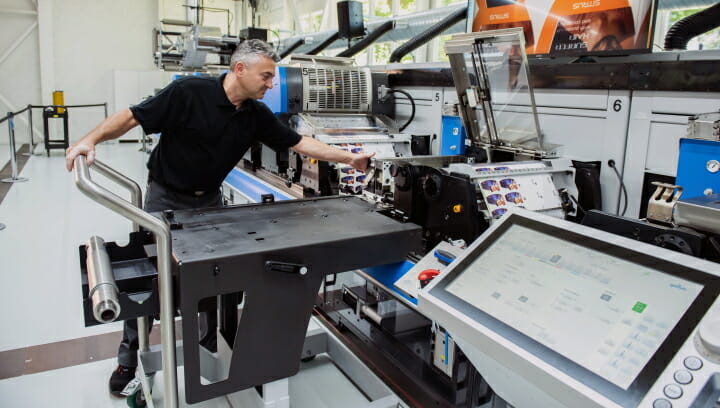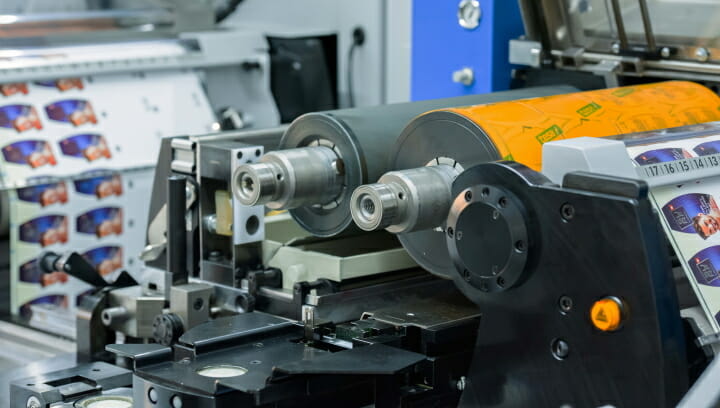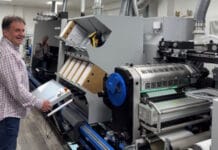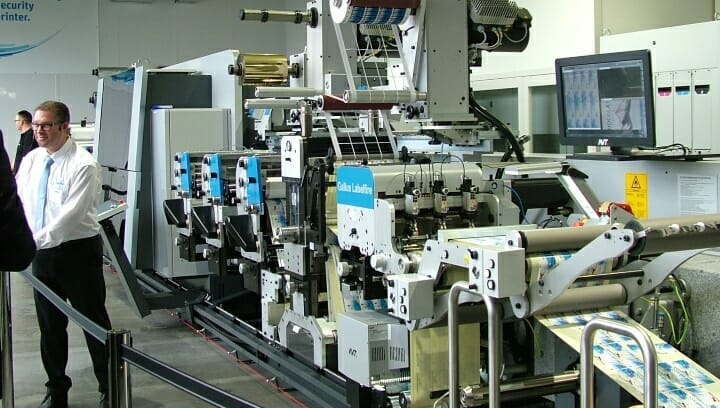
Flexible press systems offer the most cost-effective production method when total cost of print is considered
Dieter Finna (Click here for a German version)
In the daily routine business of label printing, unforeseen circumstances frequently disrupt the planned process steps. Often deadline variations or short-term changes mess-up the order sequence or delay the process. A perfectly designed process should be able to adapt quickly to new demands and the prerequisites for such flexibility are created in process management.
One of the central tasks in process management is to analyse the causes of disruptive factors and to find solutions that keep the effects on the planned work procedures to a minimum. Thus the aim is to avoid or minimise time loss or additional effort.
As well as analysing short-term disruptive factors, process management also pursues medium- to longer-term goals. This involves examining market trends and their impact on the product portfolio. To ensure that equipment can be used universally even when market trends change, great importance is attached to high flexibility of press systems in terms of their configurability and retrofitting. This flexibility, as we will see, spawns useful advantages for day-to-day business.
Process analysis reveals differences in efficiency
Today’s narrow web presses offer great operational convenience due to their modular design and high degree of automation. However, a more detailed analysis of the time required for individual workflow steps reveals significant differences in the set-up and changeover times of the various press systems on offer. In routine business, this leads to significant differences in efficiency. These become particularly noticeable when external influencing factors come into play and not everything goes according to plan. Which is why larger label and packaging printers carefully examine the process times of individual workflow steps of the press systems they use and apply their findings to optimise the process sequences.
Practical reference values
Performance data for current press systems in practical operation serve as reference values for the following examples. As basic equipment they have either UV offset or UV flexo printing units which may be supplemented by additional configurations with all other common printing processes. The options for expansion include rotary screen printing, partial solvent gravure printing, foil hot embossing and foil cold application, coating and lamination.
Procedures that process management examines to control external factors, among others:
♦ Process changeover times
♦ Set-up times for job changes
♦ Reproducibility of orders
♦ Web transport
♦ Web paths
♦ Substrate diversity
♦ Multi-Web
♦ Flying Inprint
♦ Digital Hybrid Solutions
Entry into the process analysis
If a company does not have any experience in process management, a pilot project is a good way to get started, in which processes with set-up times are in the foreground; for example the analysis of planned or last-minute order changes. Since their number varies from print shop to print shop, process management determines how often disruptive factors occur and how influential they are. It then identifies ways in which the disruptive factors can be eliminated. Here are a few examples:
Influence of process change times
In the analysis, the structure of a label printing company shows an average of four job changes per shift where a process adjustment is necessary. The pre-determined changeover time for the exchange of a printing unit is 30 minutes. In concrete terms, this means that each unscheduled process change delays subsequent jobs accordingly and deadlines have to be rescheduled in some cases. If process management compares the process change times of equivalent press systems, it will show that a machine system with optimised web run requires only 5 minutes for a process change instead of 30 minutes.

With an average of four process changes per shift, this leads to a time saving of 100 minutes, or allows 20% more production time per shift. The difference results from the fact that with the second machine system, the web does not have to be separated during the process change.
If process changes become necessary at short notice in daily routine business, they have virtually no effect on scheduling and machine availability with this press system. The system is therefore much less susceptible to external influences and production is more cost-effective.
Influence of ink or coatings changes
Ink and coatings changes are among the routine activities when changing over to a new job and occur relatively frequently in daily business. When changing from matt to gloss coating, for example, all parts of the inking unit such as the ink chamber, ink pump with hoses and ink reservoir must be replaced or cleaned. Alternatively, and relatively simply, the changeover time of the press could be shortened by changing the entire printing unit. The prerequisite is that the press system allows this without the need to break the web.

To do this, a printing unit is prepared with the new coating outside the running press and swapped in at the end of the job. This takes around 5 minutes, compared to around 15 minutes for cleaning the inking/coating unit during changeover. With the possibility of changing printing units without breaking the web, unscheduled ink/coating changes have hardly any impact on the scheduling of daily business.
In addition, there is the possibility of producing »Flying Inprint«. As in the example above, this production method is based on preparing a new printing unit while the press is running and then switching the printing units. This means that text or ink can be changed even at short notice avoiding press stoppages, without any changeover time, and with the lowest production costs.
Automation during job changeover
Process management can also focus on qualitative goals, for example the reproducibility and thus the production reliability of repeat jobs. In many printing plants, around two-thirds of their work consists of jobs with minor changes or repeats. Such a structure is ideal for automated job changeover. The complete make-ready data for the press is retrieved from a job file and all the necessary parameters such as web leads, longitudinal and cross register, print parameters and the press’s die-cutting tool are set automatically.
The machine systems also show significant differences in automatic job changes, which are reflected in the reproducibility of the print quality. Process management records how often deviations occur during automatic changeovers and how much time is needed for readjustment. Maximum reproducibility is achieved with press systems in which direct drive servo motors control the drive rollers. Printing units in which gear wheels or belts are used do not have this precision.
The press systems also show significant differences when it comes to automatic job changes, which are reflected in the reproducibility of print quality. In process management, it is recorded how often there are deviations from the standard with automatic changes and how long it takes to readjust. Maximum reproducibility is achieved with systems in which direct drive servo motors control the drive rollers. Printing units in which gears or belts are used do not have this precision.
MultiWeb and product portfolio expansion
When changing substrates, modern presses access a substrate database and adjust the web tension across the entire web path, dependent on the material.

The quality of web transport falls within the interest of process management, both for material changes and for material diversity. It determines how flexibly a press system can process different substrates.
Web tension control is particularly important for new trend multi-web applications. Two webs are printed inline and then spliced together. The substrate data of the two webs must be definable independently of each other so that the webs fit each other in-register. The multi-web label must not curl or loosen due to different elongation factors before or during application to the end product.
For multi-web or security applications, a punching option is often required in the print area. For this purpose, it must be possible to install punching and counter-punching cylinders in position with minimal mechanical effort. This is the only way to ensure cost-effective production.

Market trends
Highly opaque white, special varnish effects or print finishing options are an increasing requirement in all consumer markets. In order to be able to follow the trends, the press systems are being reviewed in process management for their expandability and flexibility. Screen printing units, which print very high film weights of ink and coatings, and also hot or cold foil application systems must be able to be integrated into a press with minimum effort and short web paths. Here, too, there are significant differences in the configurability of the systems, which determine the amount of waste during make-ready.
High degree of automation and maximum flexibility
The examples listed above show how often disruptive factors influence day-to-day business and how great their impact is on planned processes. In the search for solutions in process management, the advantages of press systems that have the greatest possible flexibility emerge. With their equipment and degree of automation, they offer the necessary prerequisites to work efficiently even under disruptive factors in day-to-day business. Even an »unfavourable« order sequence or increased set-up times barely affect the efficiency of the production processes. Thus, flexible press systems offer the most economically efficient option for routine daily business, even with their associated higher acquisition costs. Process management proves this when comparing the costs of individual work steps and in a total cost comparison of press systems.























